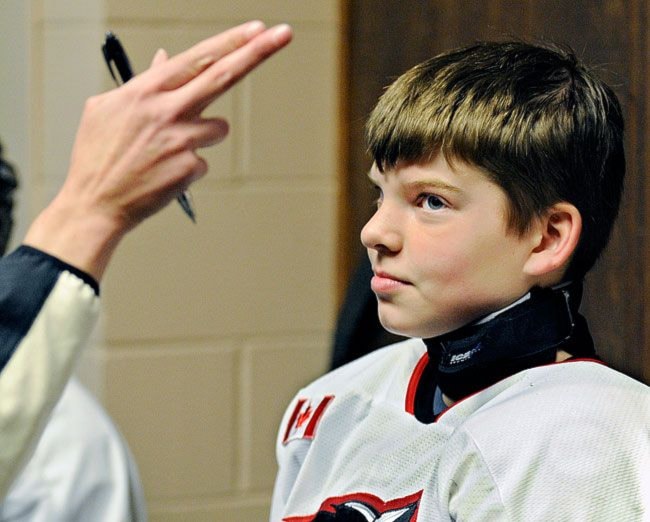When it comes to concussions in hockey, the rule of thumb for coaches is: When in doubt, sit them out.
The Whitehorse Minor Hockey Association wants less doubt, and more verifiable evidence.
To make this happen, the association has started using the Sport Concussion Assessment Tool 2, or SCAT2, this season.
“Certainly, concussions are an issue in all contact sports, so what we’ve done is gone a little bit above and beyond what is required,” said Marlene Jennings, a member of the association’s board. “We recognize the potential is pretty high for concussions. Management is a big part of it.”
SCAT2 aids medical professionals in diagnosing concussions. The third International Conference on Concussion in Sport held in Zurich in 2008, resulted in the Zurich guidelines, which recommend the use of SCAT2 by sports organizations.
The design of the tool is simple. Athletes are taken through a series of physical and cognitive tests at the start of the season to establish a baseline of what is normal. Then, following a head injury, the tests are repeated to see of there is any change.
“In the event of an injury, when one of these guys gets in front of a medical professional, they’ll know what’s normal,” said Jennings. “That’s a huge factor in determining how severe a concussion may be and to make a diagnosis that will aid in a safe return.”
The physical component of SCAT2 includes a balance test and the Glasgow Coma Scale, which measures a person’s conscious state. There are parts that resemble the sobriety exams that police officers put suspected drunk drivers through.
The cognitive portion of the test asks simple questions, like, what is today’s date? And what time is it?
Athletes are also given memory tests, asking them to repeat a list of five unrelated words and a series of numbers.
The SCAT2 is designed for 10 years old and older.
Since some kids might regularly find it difficult to list the correct date, establishing a personalized baseline is vital for youngsters, said association president Carl Burgess.
“The range of responses between kids is quite large,” said Burgess. “SCAT2 is state of the art that folks are pointing to and using regularly.
“It aids the proper diagnoses if there is an incident (involving a head injury) and, as well, it aids the return-to-play process.
“If there is an incident that there’s a suspected head injury, an attending physician will use that baseline.”
Only teams from Whitehorse’s representative club, the Mustangs, are required by the association to use SCAT2 since those are the teams that will potentially play contact hockey. (Whitehorse’s local leagues are non-contact.)
However, other teams – and even athletes from other sports – can use SCAT2 on a voluntary basis.
The Whitehorse Women’s Hockey Association is on board with the idea.
“We’re trying to set up a time where all the ladies can be assessed as well,” said Vanessa Bogaert, president of the association. “We’ll take the cost of it this time around, but say next year, if people want it, they’ll have to invest themselves. But this year we’re offering it from the league.”
The women’s league does not need to look at NHL superstar Sidney Crosby, sidelined for significant portions of the last two season with concussion symptoms, to understand the danger of the traumatic brain injury. The women’s league had two confirmed concussions during last season and those players “aren’t able to play this season due to continued affects of the concussion,” said Bogaert.
“One of my kids got a concussion a couple of weeks ago from falling off the monkey bars at school,” said Jennings. “It happens everywhere and I think a lot of it goes unreported. Kids have headaches or their neck is sore.”
The original SCAT does not involve asking questions to an athlete prior to a head injury. Instead, the test is limited to questions following an injury, asking players to rate symptoms such as headache, vision problems, confusion, on a scale of 0 to 6.
Both SCAT and SCAT2 take into account common symptoms of concussions such as loss of consciousness, seizures or convulsions, amnesia, neck pain and more.
SCAT2 is used by many professional sports leagues, including the MLB, CFL, NFL, NHL, IIHF and FIFA.
“Now everyone uses it,” said Shelley Gallatly, the athletic therapist who is conducting the test for the Mustangs.
There are even two SCAT2 smartphone applications – one free and one costing $3.99 – that can be downloaded by medical professionals and team staff.
The Canadian Pediatric Society released a study last week recommending that contact hockey be limited to players 13-years-old and up.
That would mean removing contact from the peewee age group and only introducing it at bantam. Currently, Hockey Canada advocates introducing checking at the peewee level.
Contact Tom Patrick at tomp@yukon-news.com
